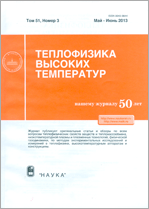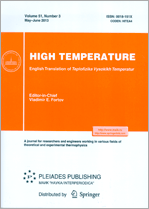|
|
Teplofizika vysokikh temperatur, 2012, Volume 50, Issue 3, Pages 450–466
(Mi tvt352)
|
 |
|
 |
This article is cited in 34 scientific papers (total in 34 papers)
Heat and Mass Transfer and Physical Gasdynamics
Development and application of a high-resolution technique for jet flow computation using large eddy simulation
D. A. Lyubimov
Baranov Central Institute of Aviation Motor Building, Moscow, 111250, Russia
Abstract:
A high-resolution technique of large eddy simulation with the implicit subgrid model (ILES) is presented for computation of compressible turbulent flows. The technique is applied to computation of jet flows. The nozzle and jet flows were computed jointly for obtaining realistic flow parameters at the nozzle exit section. Two approaches to the flow simulation in the boundary layer and in the nozzle are considered. The Reynolds-averaged Navier–Stokes (RANS) equations are used for the boundary layer description in the first approach. For the RANS/ILES method, the influence of the order of difference approximation of convection terms in the Navier–Stokes equations on the resolvability of the developed method is shown. The computations were performed for subsonic and off-design supersonic jets on a grid containing $1.1\times10^6$ cells. It is found that an increase in the order of the difference approximation from five to nine enables the accuracy of results to be improved without increasing the number of computation grid cells. The high workability of the method is demonstrated for computation of supersonic flows with separations. In the second approach, the largest eddies in the boundary layer were resolved explicitly, and the flow near the wall was described by the simplified wall model (WM). Use of the WMILES method for joint computation of the nozzle and jet flows made it possible to refine the description of the turbulent mixing layer near the nozzle exit section and improve the accuracy of agreement with the experiment. The flows in different-shape chevron nozzles and their jets were jointly computed using the WMILES method on the grids with $(2.3$–$2.5)\times 10^6$ cells. The agreement of the computations with the experiment for the level of maximum fluctuations in the mixing layer was improved appreciably as compared to the computations using the RANS/ILES method. A possible explanation is found for the growth in high-frequency noise in the investigated chevron nozzles, which is observed in the experiment.
Received: 28.12.2010
Citation:
D. A. Lyubimov, “Development and application of a high-resolution technique for jet flow computation using large eddy simulation”, TVT, 50:3 (2012), 450–466; High Temperature, 50:3 (2012), 420–436
Linking options:
https://www.mathnet.ru/eng/tvt352 https://www.mathnet.ru/eng/tvt/v50/i3/p450
|


|





 Contact us:
Contact us: Terms of Use
Terms of Use
 Registration to the website
Registration to the website Logotypes
Logotypes








 Citation in format
Citation in format 
